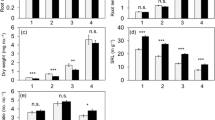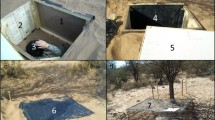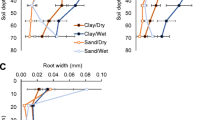Abstract
The present study is an attempt to investigate the pattern of morphological variability of the short roots of Norway spruce (Picea abies (L.) Karst.) growing in different soils. Five root parameters – diameter, length and dry weight of the root tip, root density (dry weight per water-saturated volume) and specific root area (absorbing area of dry weight unit) were studied with respect to 11 soil characteristics using CANOCO RDA analysis. The investigation was conducted in seven study areas in Estonia differing in site quality class and soil type. Ten root samples per study area were collected randomly from the forest floor and from the 20 cm soil surface layer. Eleven soil parameters were included in the study: humus content, specific soil surface area, field capacity, soil bulk density, pH (KCl and H2O dilution's), N and Ca concentrations, Ca/Al and C/N ratios, and the decomposition rate of fine roots (<2 mm dia.). Root morphological characteristics most strongly related to the measured soil characteristics in the different sites were specific root area, root density and diameter of the short roots, the means varying from 29 to 42 m2 kg−1, from 310 to 540 kg m−3 and from 0.26 to 0.32 mm, respectively; root density being most sensitive. The most favourable site and soil types resulting in fine roots with morphological characteristics for optimizing nutrient uptake (e.g. low short root density and high specific root area) were Umbric Luvisol (Oxalis), Dystric Gleysol (Oxalis) and Gleyic Luvisol (Hepatica). These soil types correspond to highly productive natural forest stands of Norway spruce in Estonia. All measured soil variables explained 28% of total variance of the root characteristics. The most important variables related to root morphology were the humus content, field capacity and specific soil surface area.
Similar content being viewed by others
References
Abrazhko M A 1973 Vsasyvayushchaya poverkhnost' kornej (Absorbing surface of roots). In Struktura i produktivnost' elovykh lesov yuzhnoj taigi (Structure and Productivity of Spruce Forests). Ed. V G Karpov. pp 132–133. Nauka, Leningrad.
Abrazhko M A 1985 O vliyanij azotnykh udobrenij na raspredelenie I fraktsionnyi sostav kornej Picea abies (Pinaceae) (The effect of nitrogen fertilizers on spatial distribution and fractional composition of Picea abies (Pinaceae) roots). Botanitcheskij zhurnal (Sov. Bot. J.) 70, 250–254.
Agerer R 1987–1993 Colour Atlas of Ectomycorrhizae. 1st–7th edn. Schwäbisch Gmünd: Einhorn-Verlag.
Brady N C 1990 The Nature and Properties of Soils. MacMillan Publishing Company, New York. 621 p.
Brunner I 1991 Comparative studies on ectomycorrhizae synthesized with various in vitro techniques using Picea abies and two Hebeloma species. Trees 5, 90–94.
Clarkson D T and Robards A W 1975 The endodermis, its structural development and physiological role. In The Development and Function of Roots. Eds. A Macfadyen and E D Ford. pp 415–436. Academic Press, New York.
Clemensson-Lindell A 1994 Norway spruce fine-root morphology and function influenced by nutrient applications in forests. Dissertation. Report 72, Swedish University of Agricultural Sciences, Uppsala.
Egli S, Amiet R, Zollinger M and Schneider B 1993 Characterization of Picea abies (L.) Karst. ectomycorrhizas: discrepancy between classification according to macroscopic versus microscopic features. Trees 7, 123–129.
Etverk I, Karoles K, Lõhmus E, Meikar T, Männi R, Nurk T, Pikk J, Randveer T, Tamm Ñ, Veibri U and Örd A 1995 Estonian Forests and Forestry. Estonian Forest Department, Tallinn 1995. 128 p.
Fitter A H 1985 Functional significance of root morphology and root system architecture. InEcological Interactions in Soil. Eds. A H Fitter, D Atkinson, D J Read and M B Usher. pp 87–106. Special publication of the British Ecological Society No. 4. Blackwell Scientific, Oxford.
Fitter A H 1987 An architectural approach to the comparative ecology of plant root systems. New Phytol. 106, 61–77.
Ford E D and Deans J D 1977 Growth of a sitka spruce plantation: spatial distributionand seasonal fluctuations of lengths, weights and carbohydrate concentrations of fine roots. Plant Soil 47, 463–485.
Frey T and Frey J 1995 Foliar chemical composition of Norway spruce with and without defoliation. In Nutrient uptake and cycling in forest ecosystems. Eds. L O Nilsson, R F Hüttl, U T Johansson and P Mathy. pp 123–129. Ecosystem Res. Rep. 21, Brussels.
Kramer P J, Kozlowski T T and Pallardy S g 1991 The Physiological Ecology of Woody Plants. Academic Press, San Diego. 657 p.
Lõhmus K and Ivask M 1995 Decomposition and nitrogen dynamics of fine roots of Norway spruce (Picea abies (L.) Karst.) at different sites. Plant Soil 168–169, 89–94.
Lõhmus K, IvaskMand Ostonen I 1995 Decomposition of fine roots of Norway spruce (Picea abies (L.) Karst.) and Scots pine (Pinus sylvestris L.) in different soils. In Role of Roots, Mycorrhizas and Rhizospere Microbes in Carbon Cycling in Forest Soil. Extended abstracts of the NorFa – workshop, Eds. H-S Helmisaari, A Smolander and A Suokas. pp 83–87. Research Papers 537, The Finnish Forest Research Institute, Helsinki.
Lõhmus K and Lasn R 1990 Spruce and pine root structures and chemical characteristics in moderate acid soils. In Above-and Below-ground Interactions in Forest Trees in Acidified Soils. Ed. H Persson. pp 74–78. Air Pollution Research Report 32, Commission of the European Communities, Uppsala.
Lõhmus K, Lasn R and Oja T 1991 The influence of climatic and soil physical conditions on growth and morphology of Norway spruce roots. In Plant Roots and Their Environment. Eds. B L McMichael and H Persson. pp 233–239. Elsevier Science Publishers, Amsterdam.
Lõhmus K and Oja T 1983 K metodike izucheniya podzemnoj chasti drevostoev (On methods of studying below-ground growth of a forest stand). Lesovedenie (Sov. For.) 4, 56–62.
Lõhmus K, Oja T and Lasn R 1989 Specific root area: A soil characteristic. Plant Soil 119, 245–249.
Lyford W H 1975 Rhizography of non-woody roots of trees in the forest floor. In The Development and Function of Roots. Eds. J G Torrey and D T Clarkson. pp 179–196. Academic Press, New York.
Nye P H 1973 The relation between radius of a root and its nutrient absorbing power (α). J. Exp. Bot. 24, 783–786.
Nye P H and Tinker P B 1977 Solute movement on the soil – root system. pp 342. Blackwell, Oxford.
Olsthoorn A F M 1991 Fine root density and root biomass of two Douglas-fir stands on sandy soils in The Netherlands: 2. Periodicity of fine root growth and estimation of belowground carbon allocation. Neth. J. Agric. Sci. 39(1), 61–77.
Orlov A Ya 1955 K metodike kolichestvennogo opredeleniya sosuschikh kornej drevesnykh porod v pochve (On the methods of quantitative determination of absorbing tree roots in soil). Byulleten MOIP. Otd. biol. (Bull.Moscow Nature Res. Soc. Biol. Sec.) 60, 93–103.
Persson H, Ahlström K and Clemensson-Lindell A 1998 Nitrogen addition and removal at Gårdsjön – effects on fine-root growth and fine-root chemistry. For. Ecol. Manage. 101, 199–205.
Peterson C A 1988 Exodermal Casparian bands: their significance for ion uptake by roots. Physiol. Plant. 72, 204–208.
Puri B and Murari K 1964 Studies in surface-area measurements of soils. 2, Surface area from a single point on the water isoterm. Soil Sci. 97, 341–343.
Robinson D and Rorison I H 1983 Relationships between root morphology and nitrogen availability in a recent theoretical model describing nitrogen uptake from soil. Plant Cell Environ. 6, 641–647.
Söderström B E and Bååth E 1978 Soil microfungi in three Swedish coniferous forests. Hol. Ecol. 1, 62–72.
Ter Braak C J F 1987 CANOCO – a FORTRAN Program for Canonical Community Ordination by [Partial] [Detrended] [Canonical] Correspondence Analysis. Principal Components Analysis and Redundancy Analysis (Version 2.1). 95 p. Agriculture Mathematics Group, Wageningen.
Vogt K A and Persson H 1991 Measuring growth and development of roots. In Techniques and Approaches in Forest Tree Ecophysiology. Eds. J P Lassoie and Th M Hinckley. pp 477–501. CRC Press, Boston.
Vogt K A, Vogt D J, Moore E E, Fatuga M B, Redlin M R and Edmonds R L 1987 Conifer and angiosperm fine-root biomass in relation to stand age site productivity in Douglas-fir forests. J. Ecol. 75, 857–870.
Author information
Authors and Affiliations
Rights and permissions
About this article
Cite this article
Ostonen, I., Lõhmus, K. & Lasn, R. The role of soil conditions in fine root ecomorphology in Norway spruce (Picea abies (L.) Karst.). Plant and Soil 208, 283–292 (1999). https://doi.org/10.1023/A:1004552907597
Issue Date:
DOI: https://doi.org/10.1023/A:1004552907597




